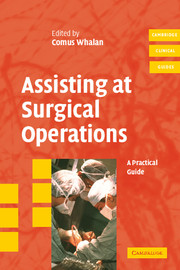Book contents
- Frontmatter
- Contents
- Contributors
- Foreword
- Preface
- PART I Introduction to the operating theatre
- PART II The operation itself
- 5 Preparing for the operation
- 6 General intra–operative principles
- 7 General stages common to operations
- 8 Sterility and the ‘sterile zone’
- 9 Tissue planes: traction and counter-traction
- 10 Surgical instruments: their names and how to use them
- PART III Assisting at special types of surgery
- PART IV Immediately after the operation
- Glossary
- Suggested further reading
- References
- Index
7 - General stages common to operations
Published online by Cambridge University Press: 18 December 2009
- Frontmatter
- Contents
- Contributors
- Foreword
- Preface
- PART I Introduction to the operating theatre
- PART II The operation itself
- 5 Preparing for the operation
- 6 General intra–operative principles
- 7 General stages common to operations
- 8 Sterility and the ‘sterile zone’
- 9 Tissue planes: traction and counter-traction
- 10 Surgical instruments: their names and how to use them
- PART III Assisting at special types of surgery
- PART IV Immediately after the operation
- Glossary
- Suggested further reading
- References
- Index
Summary
Most operations can be broken down into a series of stages. Not all operations contain every stage. These stages include the following.
Preparation by the anaesthetist
This includes such procedures as inserting intravascular cannulae, which may be intravenous (peripheral or central) or intra–arterial, placing monitoring electrodes and warming blankets, administering the anaesthetic itself (general, regional and/or local), endotracheal intubation, and administering other drugs that may be needed, such as heparin or prophylactic antibiotics. The number of these procedures needed varies greatly, depending on the patient's fitness and the type of operation. For a small operation in a fit patient, anaesthetic preparation may take under five minutes, while for a major operation in an unfit patient, it may take well over an hour.
Unfortunately, some surgeons resent this preparation time, as they feel their time is being wasted by the anaesthetist. In the author's (perhaps heretical) opinion, this resentment suggests an unprofessional lack of respect for colleagues. While the surgeon may feel, for example, that an arterial line is unnecessary, it is the anaesthetist who will have to contend with intra–operative hypotension should it arise.
Setting up (positioning the patient and equipment)
Patient positioning
Anaesthesia, particularly general anaesthesia, renders the patient helpless and therefore dependent on the theatre staff to avoid injury. Space limitations do not allow a proper explanation here of the large number of different positions in which patients are placed for different operations. Several excellent textbooks have been written on this subject, and readers are referred to these (see ‘Suggested further reading’, p. 201).
- Type
- Chapter
- Information
- Assisting at Surgical OperationsA Practical Guide, pp. 30 - 34Publisher: Cambridge University PressPrint publication year: 2006

